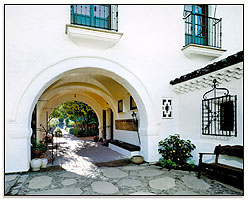Directory:Allied Arts Guild
Allied Arts Guild is a beautiful and historic garden oasis, home to unique shops, open artists' studios, and a charming restaurant. Since 1929, Allied Arts Guild has provided an inspiring environment for working artists, beautiful gardens and shops for visitors, and support for critically ill children at the Lucile Packard Children’s Hospital.
The Allied Arts Guild today continues to fulfill its founders' original dream of a European-style crafts guild. COME VISIT US soon and enjoy the refreshing peace and beauty unique in our fast-paced world. See, feel and become part of the ongoing history of the Allied Arts Guild.
Allied Arts Guild is available for shopping, lunching, relaxing and hosting special events such as weddings, receptions, seminars, and luncheons. Allied Arts has special events year round, such as the Annual Sales, Mother's Day Tea, and festive Christmas events.
Allied Arts Guild is conveniently located at the southern most end of Menlo Park, California.
History
Allied Arts Guild stands on part of what was once a vast 35,250-acre land grant dating back to the late 1700s. A king of Spain, probably Charles IV, ceded the property to Don Jose Arguello, commander of the Presidio of San Francisco. It was called Rancho de las Pulgas, literally "Ranch of the Fleas"!
In 1929, wealthy art lovers Delight and Garfield Merner bought 3.5 acres of the land located at the edge of Menlo Park. Working closely with architect Gardner Dailey and artist Pedro de Lemos, they began to realize their dream of creating an arts guild in California. The Merners' goals were to provide a serene, beautiful workplace for artists; to encourage the crafting of handsome objects for everyday use; and to support all peasant or folk art, especially that of early California.
The Guild's iron and wood shops were the first in operation because they were needed in the construction of the rest of the complex. The original barn and sheds on the grounds were preserved, and the main building was constructed on the framework of the old farmhouse. New buildings of Spanish Colonial design were added. Ansel Adams was the Guild's photographer of record and took the first interior and exterior photographs shortly after the buildings were completed.
Delight Merner was a talented, self-taught decorator with a great sense of color. She believed that blue was a difficult color to use for interiors but was a perfect color for outdoors, where it set off green foliage and reflected the sky. Her garden furniture was always painted blue.
The gardens were inspired by the gardens the couple had visited in Spain and were named in the Spanish manner: The Court of Abundance, at the entrance to the main building; The Garden of Delight, or Blue Garden; and Cervantes Court, the inner courtyard featuring a mural of Cervantes dedicating "Don Quixote" to his patron, Count de Lemos.
Paths were paved with stones from nearby San Francisquito Creek; and the tiles and objects of art used to decorate the walls were brought from Spain, Tunis and Morocco. Mosaics and frescoes were executed by Maxine Albro and the de Lemos family. The Guild's logo was designed by Mr. de Lemos, who arranged the letters AAG in a monogram depicting a boat sailing upon a tranquil sea.
The artists who occupied the studios were chosen on the basis of the quality of their work, since, in Mrs. Merner's words, "Every object which goes from the Guild must measure up to a certain standard of fine design and craftsmanship."
In 1932, the Merners' interest in the Stanford Home for Convalescent Children prompted them to invite its Palo Alto Auxiliary to provide lunch service at Allied Arts Guild for the benefit of the Home. Irma McBryde, a friend of the Merners, trained the approximately 25 young women (no one over 35 was admitted!) and set a high standard for correct service. Since the complex lacked a kitchen, auxiliary members prepared food in their homes and brought it to the Guild to serve. Gracious service was of prime importance. Lunch cost 75¢; and on the first day, they served eight guests and earned $6.00!
Today's Palo Alto auxiliary members still stress gracious service. The restaurant is a popular setting for luncheon, weddings, receptions, showers and special meetings.
The Merners retired from active operation of Allied Arts Guild in 1935 and leased the complex to the Home's Senior Auxiliary. Later, Allied Arts Guild Associates, Inc. bought the property and continued to operate it for the Home's benefit. In 1951, the Woodside-Atherton Auxiliary assumed its trusteeship and management. This auxiliary has been landlord, shopkeeper, supporter of the arts and protector of this historic site since that time.
Used with permission, Allied Arts Guild.
External links
Website
Allied Arts Guild website design by LunaGraphica Inc
